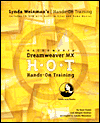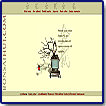Macromedia Dreamweaver
MX Hands-On Training
"A Great Way to Learn Dreamweaver MX!"

Title:
Macromedia Dreamweaver
MX Hands-on Training
Author: Garo
Green, Abigail Rudner
Publisher:
Peachpit Press http://www.peachpit.com
Publication Date:
November 2002
Pages: 712 pages
with CD
ISBN: 0-321-11271-7
Price:
$44.99
Macromedia Dreamweaver MX Hands-On-Training is the latest, updated version of the highly acclaimed tutorial from leading Web-design trainers Garo Green and Abigail Rudner. It's great for readers who want to learn how to use Dreamweaver by simply following the step-by-step exercises in this easy to read book. Further, the advanced sections of the book show you how to create interactive, moving elements in your Web site, plus how to download and use the hundreds of free extensions available online to Macromedia Dreamweaver users. And throughout the book, there are useful bits of information about HTML, online type, Web color, and more, while QuickTime movie tutorials demonstrate complex techniques.
This book is appropriate for both PC and Macintosh users. Check out the Peachpit Press Web site (http://www.peachpit.com) for more information about the book and other books in the Hands-On-Training series. Also check out Lynda Weinman's Web (http://www.lynda.com) site for information on other H.O.T. books and classes.
What I like:
- Step-by-step instruction;
- Screen shots on almost every page;
- Notes, Tips, and charts galore;
- QuickTime movies;
- CD full of extra goodies and demo software.
Dreamweaver MX Hands-on Training is divided into an introduction, 20 chapters or lessons and an appendix.
Introduction--describes basics about how the book works and background on the authors.
Chapters 1 through 20 cover the following:
- Chapter 1: Background--presents information on: definitions, concepts, and guidelines to help your hands-on Dreamweaver MX training. It includes helpful charts on File-naming conventions; Filename extensions; and DHTML terms.
- Chapter 2: Interface--discusses: the basic concepts of the program's interface. In addition, it also shows you how to set up Dreamweaver MX preferences. This chapter has excellent charts of Object panel types; Launcher preferences; Launcher features; Launcher shortcuts; Document toolbar features; Document window features; and Shortcut keys.
- Chapter 3: Site Control--covers: information on building your Dreamweaver MX site management skills. Very important chapter on the necessity of defining a site in Dreamweaver with a root folder so that Dreamweaver can automatically update your pages when you add, modify, move, or delete files or folders. There is a chart on Path notations and an excellent notation explaining Absolute vs. relative URLs. It includes six exercises.
- Chapter 4: Basics--presents information on: defining sites; creating and saving a page; inserting and aligning images and text; linking images and text; coloring text links; and inserting META descriptions for search engines. Walks you step-by-step through the process of creating pages and sites. It includes charts on Color picker options and Page properties. It includes eight exercises. See image to the left for a view of the site you will be working on in the book.
- Chapter 5: Linking--provides information on: linking with point to file; linking to new source files; browse for file and link history; email links; named anchors; image maps; and linking to files. There are no charts but it does have a great section on anchors with screenshots which simplify the process. It includes seven exercises.
- Chapter 6: Typography--covers: how to set font styles, font sizes, font colors, and font faces, plus making bulleted lists, definition lists, and unordered lists. Informational charts of Font sizes; HTML text and image alignment options; Ordered, unordered, and definition lists; HTML styles; and using Flash text are included. There are eight exercises.
- Chapter 7: Tables--gives you information on: creating custom tables; inserting rows and columns; creating color schemes; handling formatting and sorting tasks; and using tables to align and position images. Useful table tricks: one for creating custom table borders, and another for making rounded table corners. There are charts on Anatomy of a table; Sorting features; Cellpad versus cellspace; and Tabular data settings. It includes eleven exercises.
- Chapter 8: Layout--discusses: techniques that allow you to position elements anywhere on your Web page, such as tracing images and layers; converting layers to tables; and working with layout tables and layout cells. The chapter includes charts on Tracing images, layers, and tables defined; Convert layers to table options; Layers to tables versus layout view; Layout view vs. standard view; and Anatomy of Layout Cells. It includes five exercises.
- Chapter 9: Frames--covers: walks you through every step of the way in creating frames and nested frames. There are charts describing Loving frames; Hating frames; Ways to save frames; HTML specifications for target names; Frame size settings; and Frames properties. Informative chapter on a difficult subject. The author hits on the basics without overwhelming you with detail. There are six exercises.
- Chapter 10: Rollovers--describes: creating rollovers such as simple, animated, pointer, multiple-event, and navigation bars; plus creating Flash buttons and inserting Fireworks HTML. There are charts describing: Creating Flash buttons; Using Flash text; and Rollover states. It includes six exercises.
- Chapter 11: Cascading Style Sheets--provides information on: using style sheets; making classes; using selectors and affecting links with selectors; and linking to a style sheet. There is are charts on Types of style sheets; and Creating styles in Dreamweaver. There are five exercises.
- Chapter 12: HTML--includes information on: the different view types in Dreamweaver; how to use the Quick Tag Editor; and cleaning up HTML and Word HTML. It includes charts on Code view options; and Options in the Clean up HTML dialog box. It also has five exercises.
- Chapter 13: Forms--provides information on: creating form objects. There is a chart on Form Objects in Dreamweaver; It has three exercises.
- Chapter 14: Behaviors--presents information on: how to use some of the behaviors that ship with dreamweaver MX; and how to download additional behaviors. It includes no charts but lots of tips. There are six exercises.
- Chapter 15: Working with Fireworks --describes: how to insert graphics into your HTML pages that were created with Fireworks; how to edit images in Fireworks MX from within Dreamweaver MX; and insert rollovers created in Fireworks MX. There is a chart for Dreamweaver MX to Fireworks MX Workflow. It includes seven exercises.
- Chapter 16: Automation--includes information on: the history panel which memorizes and replays steps; and how to create a Web photo album. There are no charts but it has three exercises.
- Chapter 17: Templates/Libraries--discusses: creating and modifying templates; and creating and modifying library items. There are no charts. It includes six exercises.
- Chapter 18: Accessibility--covers: how to use the accessibility features in Dreamweaver MX to make Web pages. This chapter includes a chart for Input tag accessibility attributes. There are five exercises.
- Chapter 19: Plug-Ins--describes: how to add plug-ins in Dreamweaver; and how to set parameters in the Property Inspector to control how and when your plug-in-based content will play. There are charts for URLs for downloading plug-ins; Sound formats; and What QuickTime supports. It has five exercises.
- Chapter 20: Getting It Online--describes: how to create a free Web hosting account with Tripod and then use Dreamweaver MX to upload a Web site. In general you learn how to set up your FTP preferences and upload your site to a Web server using Dreamweaver MX. There are charts for FTP information for Tripod; FTP settings in Dreamweaver MX; and Reports dialog box options. It has four exercises.
- Appendix A: A Troubleshooting FAQ: gives you frequently asked questions and answers.
- Appendix B: Online Resources: provides online sources.
For running Dreamweaver MX, you need:
PC:
- Pentium II 300MHz+;
- Windows 98 SE, Windows Me, Windows NT 4 (Service Pack 6), Windows 2000, or Windows XP;
- 96MB RAM (128MB recommended);
- 16-bit color monitor capable of 1024 x 768 or better;
- CD-ROM drive.
Macintosh:
- Power Mac G3+;
- Mac OS 9.1 or higher, or OS X 10.1 and higher;
- 96MB RAM (128MB recommended);
- 16-bit color monitor capable of 1024 x 768 or better;
- CD-ROM drive.
Web Page Design: Macromedia Dreamweaver MX
| Educational | Books | Utilities | Web Tools | Legal | Articles
